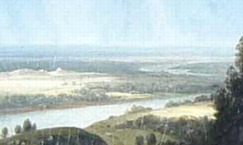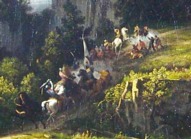

One of the first artists to use
this technique was Masaccio (Italian, 1401?-1428). Aerial perspective
is also referred to as atmospheric perspective.
Examples of pictures in which artists have used aerial perspective:

Leonardo da Vinci, Mona Lisa (La Joconde) (1479 - d. before
1550), c. 1503-1506, oil
on wood panel,
77 x 53 cm, Louvre. Many artists have created their own versions
of this image. See landscape,
Renaissance,
sfumato, and xenophobia.

T. Worthington Whittredge (American, 1820-1910),
Fight Below the Battlements, 1849, oil on canvas,
Kresge Art Museum. Wittredge was a member of the Hudson River School of painters. Toward
the horizon on the left side of this painting, we can see Whittredge's
use of aerial perspective.

Look more closely at this (detail of the) deepest part of Whittredge's
picture.

Compare its depth of color
to that seen in the foreground.
Georges Seurat (French, 1859-1891), Bathing at Asnières (Une Baignade, Asnières), 1883-1884 (retouched 1887), 79 x 118 1/2 inches, National Gallery, London. Also see Neo-Impressionism.
Also see aerial view.
https://inform.quest/_art
Copyright © 1996-![]()